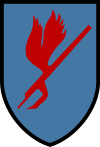| No. 6 Squadron RAF | |
|---|---|
 | |
| Active | 31 January 1914 – 1 April 1918 (RFC) 1 April 1918 – 31 May 2007 (RAF) 6 September 2010 – present |
| Country | |
| Branch | |
| Type | Flying squadron |
| Role | Multi–role combat |
| Part of | No. 1 Group (Air Combat) |
| Home station | RAF Lossiemouth |
| Nickname(s) | 'The Flying Tin Openers'[1] |
| Motto(s) | Oculi Exercitus (Latin for 'The eyes of the army')[2] |
| Aircraft | Eurofighter Typhoon FGR.4 |
| Battle honours |
|
| Commanders | |
| Current commander | Wing Commander G Montgomery |
| Insignia | |
| Squadron tail badge |  |
| Squadron badge heraldry | An eagle, wings elevated, preying on a serpent. The use of the Royal Regiment of Artillery's red lightning bolt on a light background, was adopted in recognition of the squadron's close cooperation with the Royal Artillery during the First World War.[3] The badge was approved by King George VI in January 1938. |
| Roundel |  |
| Aircraft codes | EA–EZ (Present) |
Number 6 Squadron of the Royal Air Force operates the Eurofighter Typhoon FGR.4 at RAF Lossiemouth.[4] It was previously equipped with the SEPECAT Jaguar GR.3 in the close air support and tactical reconnaissance roles, and was posted to RAF Coltishall, Norfolk until April 2006, moving to RAF Coningsby until disbanding for the first time in its history on 31 May 2007. The squadron officially reformed as a Typhoon squadron on 6 September 2010.[5] No. 6 Squadron is unique in having two Royal standards, having been awarded its second one by King Abdullah I of Jordan in October 1950 due to its long period of service in the Middle East.
- ^ "1939 – 1945". 6 Squadron RAF Association. 12 January 2017. Retrieved 10 June 2020.
- ^ Pine, L.G. (1983). A dictionary of mottoes (1 ed.). London: Routledge & Kegan Paul. p. 160. ISBN 0-7100-9339-X.
- ^ Smith, Peter C. (1974). Royal Air Force squadron badges (1 ed.). St. Ives [Cambs.]: Balfour Publications. p. 14. ISBN 0-85944-012-5.
- ^ Cite error: The named reference
Courierwas invoked but never defined (see the help page). - ^ Dsouza, Cavin (5 October 2010). "Eurofighter Typhoon replaces Tornado F3 in No. 6 Squadron of the Royal Air Force". Defence Aviation. Retrieved 24 July 2015.